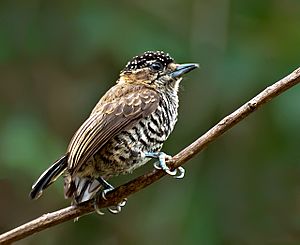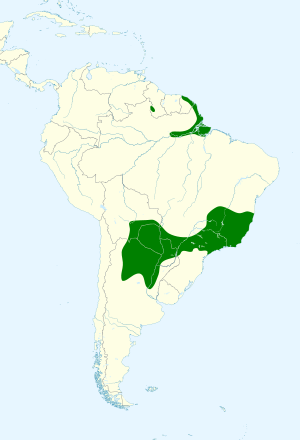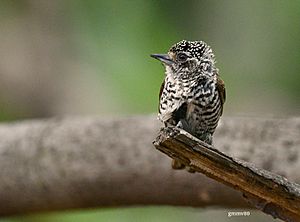White-barred piculet facts for kids
Quick facts for kids White-barred piculet |
|
|---|---|
 |
|
| Conservation status | |
| Scientific classification | |
| Genus: |
Picumnus
|
| Species: |
cirratus
|
 |
|
The white-barred piculet (Picumnus cirratus) is a small bird that belongs to the woodpecker family. It lives in several countries in South America, including Argentina, Bolivia, Brazil, French Guiana, Guyana, Paraguay, and Uruguay.
Contents
About the White-Barred Piculet
The white-barred piculet was first described in 1825 by a Dutch zoologist named Coenraad Jacob Temminck. Scientists recognize six different types, or subspecies, of this bird.
The name cirratus comes from a Latin word meaning "curly headed." This refers to the patterns on its head.
What Does It Look Like?
The white-barred piculet is about 10 centimeters (4 inches) long. It weighs between 6.3 and 12 grams (0.2 to 0.4 ounces).
Male birds have a black cap on their head with a red patch on the forehead. They also have white spots on the rest of their cap. Their face is brownish with faint dark bars and a white stripe behind the eye. Their back is dull brownish. Their tail is dark brown with some white patches.
Their throat is white or pale with dark bars. The rest of their belly is white with black bars.
Female birds look very similar to males, but they do not have the red patch on their forehead. Young birds are usually duller and darker. They have more noticeable bars on their back and belly.
Different types of white-barred piculets can have slightly different colors or patterns. For example, some might have a darker face or more bars on their throat.
Where Does It Live?
The white-barred piculet lives in two main areas that are far apart. You can find them in many different places, like:
- Wet and dry woodlands
- Edges of forests
- Thick bushes
- Forests along rivers in grassy areas
- Bamboo patches
- Overgrown parks and gardens
They can live from sea level up to about 2,100 meters (6,900 feet) high.
Behavior and Life Cycle
Movement
The white-barred piculet stays in the same area all year round. It does not migrate.
Feeding Habits
This bird usually looks for food by itself. Sometimes, it might join small groups of different bird species. It eats:
- Ants
- Insect larvae (young insects)
- Insect eggs, especially from beetles that bore into wood
- Other small invertebrates (animals without backbones)
It drills holes in wood to find food. It might also drink sap that comes out of trees. They mostly feed on small branches and twigs, but also on vines and bamboo. They can even hang upside down to get food!
Reproduction
White-barred piculets in the northern parts of their range breed from July to December. Those in the southern parts breed from September to March.
Both the male and female bird dig a nest hole. They usually make it in a thin tree branch. The nest can be as low as 2 meters (6.6 feet) off the ground. They lay two to four eggs. Both parents help to incubate the eggs.
Sounds and Calls
The white-barred piculet makes a very high, fast trill sound, like "trrrrriut." It also has a "tsirit, tsick" call. When it drums on dead wood, it makes a loud, sharp sound.
Conservation Status
The IUCN (International Union for Conservation of Nature) says the white-barred piculet is a species of "Least Concern." This means it is not currently in danger of disappearing.
It lives in a very large area. Even though its population size is not known and might be getting smaller, it's not decreasing fast enough to be a big worry right now. There are no immediate threats to the species. It is quite common in most places where it lives and can be found in protected areas. However, in some cities, its forest home is shrinking.
See also
 In Spanish: Carpinterito variable para niños
In Spanish: Carpinterito variable para niños




